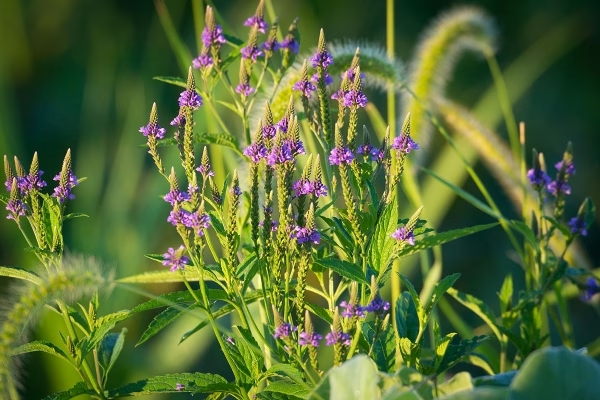
Blue Vervain
Botanical Name
:
Verbena hastata
Plant Type
:
Herbaceous perennial
Seasons
:
Plant in late fall; blooms in mid-summer to early fall
Sun Level
:
Full sun (at least 6 hours of sunlight daily); can tolerate light shade
Ideal Soil Temperature for Planting
:
68 to 95°F (20 to 35℃)
Soil Type
:
Moist, well-drained soil; adaptable to various soil types
Hardiness Zones
:
3–9 (USDA)
Germination
:
Takes 2–3 weeks for germination to occur
P.H. Level
:
Mildly acidic to slightly alkaline (6.5–7.5)
Water/Irrigation
:
Needs consistent moisture, especially during establishment
Fertilization
:
Opt for liquid or granular fertilizers with balanced NPK ratios, applying them monthly throughout the growing season
Habit
:
Clumping, erect, branching
Propagation
:
Seed, division, or vegetative cuttings
Final Plant Height
:
3–5 ft
Spread
:
1–3 ft
Flowers
:
Small, densely packed, violet-blue to purple flowers arranged on slender spikes
Attracts
:
Bees, butterflies, other pollinators
Uses
:
Wildflower gardens, meadows, borders, naturalized areas
Companions
:
Plants that thrive in similar conditions, such as coneflowers (Echinacea), black-eyed Susans (Rudbeckia), and asters
Pruning
:
Deadhead spent flowers to prolong blooming. Cut back stems in late fall or early spring
Toxicity
:
Generally considered non-toxic
Pests
:
Aphids, spider mites
Diseases
:
Powdery mildew, leaf spot
Fun Fact
:
The hastata part of the name refers to the spear-shaped leaves
Confused With
:
Other Verbena species, especially other blue or purple-flowered varieties
Additional Info
:
Provides nectar for pollinators and supports native ecosystems
Botanical Name
:
Verbena hastata
Plant Type
:
Herbaceous perennial
Seasons
:
Plant in late fall; blooms in mid-summer to early fall
Sun Level
:
Full sun (at least 6 hours of sunlight daily); can tolerate light shade
Ideal Soil Temperature for Planting
:
68 to 95°F (20 to 35℃)
Soil Type
:
Moist, well-drained soil; adaptable to various soil types
Hardiness Zones
:
3–9 (USDA)
Germination
:
Takes 2–3 weeks for germination to occur
P.H. Level
:
Mildly acidic to slightly alkaline (6.5–7.5)
Water/Irrigation
:
Needs consistent moisture, especially during establishment
Fertilization
:
Opt for liquid or granular fertilizers with balanced NPK ratios, applying them monthly throughout the growing season
Habit
:
Clumping, erect, branching
Propagation
:
Seed, division, or vegetative cuttings
Final Plant Height
:
3–5 ft
Spread
:
1–3 ft
Flowers
:
Small, densely packed, violet-blue to purple flowers arranged on slender spikes
Attracts
:
Bees, butterflies, other pollinators
Uses
:
Wildflower gardens, meadows, borders, naturalized areas
Companions
:
Plants that thrive in similar conditions, such as coneflowers (Echinacea), black-eyed Susans (Rudbeckia), and asters
Pruning
:
Deadhead spent flowers to prolong blooming. Cut back stems in late fall or early spring
Toxicity
:
Generally considered non-toxic
Pests
:
Aphids, spider mites
Diseases
:
Powdery mildew, leaf spot
Fun Fact
:
The hastata part of the name refers to the spear-shaped leaves
Confused With
:
Other Verbena species, especially other blue or purple-flowered varieties
Additional Info
:
Provides nectar for pollinators and supports native ecosystems
Written by Nondiah Khalayi – https://www.linkedin.com/in/nondiah-khalayi/

